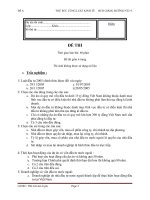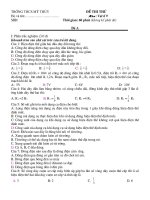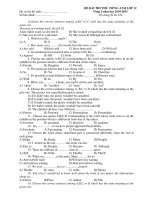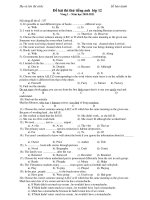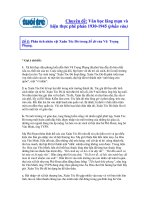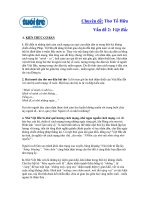Bai Thi Thu So 2 T Anh Ts Dai Hoc 2008Da Bam Sat Huong Dan Moi Nhat Cua Bo.doc
Bạn đang xem bản rút gọn của tài liệu. Xem và tải ngay bản đầy đủ của tài liệu tại đây (124.22 KB, 5 trang )
PRACTICE TEST 2
Choose the word with the different stress pattern.
1. A. dangerous
B. probably
C. several
D. together
2. A. energy
B. erosion
C. mineral
D. quantity
3. A. attention
B. conclusion
C. extinction
D. interrupt
4. A. audience
B. curious
C. prevention
D. relevant
5. A. reliable
B. exploration
C. manufacture
D. application
Choose the word or phrase which best fits each gap of the sentence.
6. The soil must be kept damp at all times or the plant will die.
A. moist
B. wet
C. dry
D. arid
7. It costs an excessive sum of money to study overseas.
A. intense
B. extensive
C. exorbitant
D. modest
8. Our grandfather is buried in that graveyard .
A. morgue
B. churchyard
C. cemetery
D. both B and C
9. We purchased a package of biscuits at the grocer's near our school.
A. brought
B. bought
C. pursued
D. sought
10. There is adequate water for the all the people of the city to use during the summer months.
A. absolute
B. extreme
C. considerable
D. sufficient
11. The boy is qualified to take part in the competition.
A. legible
B. legal
C. capable
D. eligible
12. John's family resided in the village for more than ten years.
A. lived
B. endured
C. stayed
D. inhabited
13. The mother scolded the boys for making too much noise.
A. disagreed
B. told off
C. punished
D. beat
14. Mary's friend was cross with her for misbehaving at the party.
A. unhappy
B. nervous
C. angry
D. worried
15. They went ahead with their plan, ignoring my counsel.
A. prediction
B. advice
C. suggestion
D. request
16. Does anyone know … this hat might tie?
A. who
B. whom
C. whose
D. to whom
17. We intend … away with the old system once we have developed a better one.
A. doing
B. to do
C. do
D. to have done
18. The old lady was … exhausted after the long walk.
A. very
B. absolutely
C. pretty
D. fairly
18. By the time you return here next year, the city … lots of changes.
A. will have
B. has had
C. will have had
D. will be having
19. The old man serves the ball so skillfully. He a good tennis player when … young.
A. can be
B. must be
C. could be
D. must have been
20. The old man is said … all his money to an old people's home when he died.
A. to leave
B. to leaving
C. have left
D. to have left
21. Han is going to the USA for his holiday. He … up for nearly a year now.
A. has saved
B. is saving
C. saves
D. has been saving
22. Nobody was injured in the accident, …?
A. was there
B. was he
C. were they
D. wasn't it
23. Something was wrong with the machine, …?
A. was it
B. wasn't it
C. were they
D. weren't they
24. If the weather stays fine, the plane … land at 8.30 local time.
A. does
B. might
C. should
D. ought
25. The house … Shakespeare was born is now open to the public.
A. that
B. where
C. which
D. who
Choose the word which best fits each gap of the passage.
Nearly all the discoveries that have been made through the ages can be found in books. The invention
of the book is one of humankind's (26) … achievements, the (27) … of which cannot be overestimated.
Books are very (28) … , providing us with both entertainment and (29) … The production of books began in
(30) … Egypt, though not if a form that is recognizable to us (31) …
The books read by the Romans, however, have some (32) … to the ones we read now. Until the (33) …
of the 15th century, in Europe all books were written by hand. They were often beautifully (34) … and
always rare and expensive. With printing came the possibility of cheap large-scale publication and
distribution of books, making (35) … mol widespread and accessible.
26. A. greatest
B. largest
C. hugest
D. fastest
27. A. important
B. importantly
C. importance
D. more important
28. A. adjusting
B. adjustable
C. adapting
D. adaptable
29. A. news
B. information
C. data
D. facts
30. A. Old
B. Antique
C. Ancient
D. Aged
31. A. today
B.
tonight
c. this day
D. this night
32. A. alike
B.
likeness
c. same
D. similarities
33. A. centre
B.
middle
c. heart
D. core
34. A. shown
B.
displayed
c. illustrated
D. drawn
35. A. knowledge
B. mind
c. brain
D. awareness
Choose the correct sentence which has the same meaning as the given one.
36. "Leave my house now or I'll call the police!" shouted the lady to the man.
- 1 –EDITED BY HO NGOC AN- DATE HIGH SCHOOL- LAMDONG
A The lady threatened to call the police if the man didn't leave her house.
B The lady said that she would call the police if the man didn't leave her house.
C. The lady told the man that she would call the police if he didn't leave her house.
D. he lady informed the man that she would call the police if he didn't leave her house.
37. He last had his eyes tested ten months ago.
A He had tested his eyes ten months before.
B. He had not tested his eyes for ten months then.
C. He hasn't had his eyes tested for ten months.
D He didn't have any test on his eyes in ten months.
38. "You should have finished the report by now," John told his secretary.
A. John reproached his secretary for not having finished the report.
B. John said that his secretary had not finished the report.
C John reminded his secretary of finishing the report on time.
D John scolded his secretary for not having finished the report.
39. "If I were you, I would take the job," said my room-mate.
A My room-mate was thinking about taking the job.
B. My room-mate advised me to take the job.
C My room-mate introduced the idea of taking the job to me.
D My room-mate insisted on taking the job for me.
40. "It's too stuffy in this room, isn't it?" said the guest.
A The guest suggested that the room should be aired.
B The guest remarked that the room should be aired.
C The guest said that the room was too crowded.
D The guest said that there was too much stuff in the room.
Choose the word or phrase which best fits each gap of the passage.
Our body needs small amounts of vitamins and minerals for good health. Vitamins are chemicals that (41) …
our body use carbohydrates, proteins, and fats. We need certain vitamins (42) … blood cells and body
chemicals. Not getting enough vitamins (43) … cause serious diseases. Long ago sailors on long sea voyages
(44) … have fresh food. They suffered from a disease (45) … scurvy. Their gums bled and their teeth fell out.
Many sailors died from scurvy.
Scurvy is caused by a lack of vitamin C. A doctor in the 1700s discovered that (46) … sailors lime juice
prevented scurvy. Citrus fruits like limes are full (47) … vitamin C. We need small amounts of certain minerals
for healthy teeth and bones. The mineral calcium is very important for (48) … strong bones. We need other
kinds of minerals to help our muscles and nerves work. Iron is (49) … important mineral for our blood.
We can get all the vitamins and minerals we need by eating a wide variety of foods. That is why 5) … need
to eat fruits, broccoli, and other vegetables along with our bread and ice cream.
41. A. helping
B. helped
C. help
D. helps
42.
A. building
B. built
C. build
D. to build
43.
A. can
B. should
D. ought to
44.
A. did
B. did not
c. must
c. had not
45.
A. is calling
B. was called
c. called
D. calling
46.
A. giving
B. give
c. gave
D. given
47.
A. for
B. by
c. with
D. of
48.
A. built
B. building
D. having built
49.
A. some
B. the
c. being built
c. a
50.
A. we
B. you
D. had
D. an
D. I
c. they
Choose the word or phrase which best fits each gap of the sentence.
51. …we went swimming.
A. Being a hot day
B. It was a hot day
C So hot was the day
D. Due to a hot day
52. If he … the doctor last week, he … now.
A. saw / is not suffering
B. saw / would not suffer
C. had seen / would not have suffered
D. had seen / would not be suffering
53. … he studied, … he became.
A. Hardly / the more confused
B. The more hardly / the less confused
C. The harder / the less confused
D. So hard / very confused
54. Professor Lockwood recommended that Michael … in chemistry.
A. not major
B. wouldn't major
C. not to major
D. isn't majoring
55. We'd better insure the house … fire.
A. in case of
B. but for
C. as a result of
D. in addition to
Read the passage and choose the best answer.
As Christmas evolved in the United States, new customs were adopted and many old ones were reworked.
The legend of Santa Claus, for example, had origins in Europe and was brought by Dutch settlers to New York in
the early 18th century. Traditionally, Santa Claus - from the Dutch Sinter Klaas - was depicted as a tall, dignified,
religious figure riding a white horse through the air. Known as Saint Nicholas in Germany, he was usually
accompanied by Black Peter, an elf who punished disobedient children. In North America he eventually
developed into a fat, jolly old gentleman who had neither the religious attributes of Saint Nicholas nor the strict
disciplinarian character of Black Peter.
Santa's transformation began in 1823, when a New York newspaper published the poem A Visit from Saint
Nicholas, which Clement Clark Moore had written to amuse his daughter. The poem introduced many Americans
- 2 –EDITED BY HO NGOC AN- DATE HIGH SCHOOL- LAMDONG
to the story of a kindly saint who flew over housetops in a reindeer-drawn sleigh. Portraits and drawings of Santa
Claus by American illustrator Thomas Nast further strengthened the legend during the second half of the 19th
century. Living at the North Pole and assisted by elves, the modern Santa produced and delivered toys to all
good children. By the late 19th century he had become such a prominent figure of American folklore that in
1897, when Virginia O'Hanlon wrote to the New York Sun
newspaper asking if Santa was real, she received a direct answer: "Yes, Virginia, there is a Santa Claus."
56. Who brought the legend of Santa Claus to the USA according to the passage?
A. Sinter Klaas.
B. Saint Nicholas.
C. A German.
D. Dutch settlers.
57. Santa Claus was traditionally described as a …
A. tall man who could walk through the air.
B. fat, jolly, old man.
C. religious figure.
D. fat man riding a white horse.
58. Santa Claus in North America was depicted as …
A. a man with the strict disciplinarian character of Black Peter.
B. a good old man with less religious character.
C. one with religious attributes of Saint Nicholas.
D. a jolly man on horseback.
59. Who was Black Peter?
A. An elf accompanying Saint Nicholas.
B. An elf who rode a white horse.
C. One of the disobedient children.
D. A popular traditional figure.
60. What word is closest in meaning to attributes?
A. Symbols of a person. B. Natural qualities.
C. Effects.
D. Outer appearance.
61. Where did the legend of Santa Claus come from?
A. The North Pole.
B. Europe.
C. North America.
D. The City of New York.
62. 1823 was mentioned as a year when …
A. Clement Clark Moore wrote his first poem.
B. Clement Clark Moore's poem made him popular.
C. Saint Nicholas visited New York.
D. the image of Santa Claus was transformed.
63. According to Clement Clark Moore's poem …
A . S a nt a Cl au s ha d n o th in g d iff e re n t in a p p ea r an c e f ro m th e traditional one.
B. Santa Claus had wings and could fly.
C. Santa Claus liked poetry.
D. Sant a Claus was a kindly saint who fle w ov er house tops in a sleigh.
64. The answer Yes, Virginia, there is a Santa Claus is an illustration for the fact that …
A. The New York Sun was popular with children.
B. Santa Claus was a prominent figure at that £time.
C. Newspapers are unreliable.
D. Virginia O'Hanlon was a reader of the New York Sun.
65. Which of the following statements is TRUE?
A . S a n t a C l a u s w a s a n i m a g i n a r y o l d m a n c r e a t e d b y a r t i s t s based on traditional figures.
B. Living in the North Pole, Santa Claus visited children at Christmas.
C. Santa Claus was a real figure living in northern America.
D. Santa Claus was a story based on Saint Nicholas and Black Peter.
Read the passage and choose the best answer.
The American Red Cross was established in 1881, largely through the efforts of Clara Barton, who had done
relief work during the Civil War. In 1900, the society was approved by Congress, and since then it has
developed until each county in the United States and its possessions is served by a Red Cross chapter. The
American Red Cross performs a great variety of services. In times of war, its biggest task is to give help and
comfort to men and women in the national armed forces, whether they are sick or well, and to assist their
families back home if they need help. Even in peacetime, Red Cross members work with these forces
whenever they may be of help.
The Canadian Red Cross Society was founded in 1896 as the first branch of the British Red Cross Society. Since
1927, however, it has been an independent national organization. Almost every activity of the American Red
Cross is carried on similarly by the Canadian one, and it served effectively in both world wars as well as in
Korea. Nevertheless, the Canadian society has some projects that are unique. Because the country is so
large and many areas are so thinly populated, the Canadian Red Cross provides outpost hospitals, nursing
stations, veterans' lodges, and traveling medical and dental clinics.
The programs of the American and Canadian Red Cross societies are dedicated to helping people at home
and abroad in times of peace and war. Both societies have millions of members. Membership dues and
voluntary contributions support the organizations and pay for their services. Despite the close relationships to
their governments, neither society receives money from any governmental funds.
66. The American Red Cross was established chiefly by ….
A. the American government B. an American woman C. the American Congress D. an American society
67. Nowadays, one branch of the American Red Cross serves ….
A. the whole USA
B. each of the States' possessions
C. all the American colonies
D. a small part of the USA
68. The word chapter in the first paragraph most probably means ….
A. a numbered division of a long fiction work
B. an independent unit or lesson in a textbook
C. a certain glorious period of time in history
D. an authorized section of a bigger organization
69. The American Red Cross members take care of the national armed forces
A. in times of war only
B. whenever they may be of help
C. in times of peace only
D. both in war and peacetime
70. The Canadian Red Cross Society came into being in the same … as the American Red Cross.
A. time
B. century
C. year
D. decade
71. The word one in the second paragraph probably refers to
A. an activity
B. the Red Cross
C. an organization
D. the first colonial
branch
72. Both organizations have … their governments.
- 3 –EDITED BY HO NGOC AN- DATE HIGH SCHOOL- LAMDONG
A. refused taking money from
B. been mainly financed by
C. gotten basic sponsorship of
D. contributed their funds to
73. The activities done by the Canadian Red Cross are … those of the American society.
A. relatively similar to B. exactly the same as
C. extremely different from
D. completely familiar with
74. Which of the followings is NOT included in the Canadian Red Cross Society's unique projects?
A. outpost hospitals
B. nursing stations
C. veterans' pensions D. medical and dental clinics
75. The noun dues in the last paragraph is closest in meaning to ….
A. certain fees for taking part in an organization
B. things that should be given to someone by right
C. the deadline to submit someone's assignment
D. things that are considered fair to someone
Choose the underlined word or phrase in each of the sentences that needs correcting.
76. Despite the metric system is used throughout the world, it is still no t c o m m on l y u se d i n t h e
U ni t e d S t a t es .
77. T he s un is a h u ge fi er y g l o b e a t a a ve r ag e d is t a n c e o f 9 3, 0 0 0 , 00 0 miles from the Earth.
78. B ec a u se W a l t e r R ee d' s eff or t s and t h os e o f t he p e o p l e w h o w o r k e d w i t h h i m , h u m a n b e i n g s n o
l o n g e r f e a r t h e dreaded dis ease of yellow fever.
79. So m e g or i l l a s be a t t he i r c h es t s as a n e xp r es s of hi gh s p ir it s .
80. The cont i nental s hel ve s i s the s hal l ow area of the oce an fl oor that is clos e s t t o t he
cont inents .
The end.
SCĐ:
Điểm:
M«n TiÕng Anh TUYỂN SINH ĐẠI HỌC 2007-2008
Lu ý:
- ThÝ sinh dïng bút tô kín các ô tròn trong mục số báo danh và mà đề thi trớc khi làm bài. Cách
tô sai:
- Đối với mỗi câu trắc nghiệm, thí sinh đợc chọn và tô kín một ô tròn tơng ứng với phơng án trả lời.
Cách tô đúng :
01
02
03
04
05
06
07
08
09
10
11
12
13
14
15
28
29
30
31
32
33
34
35
36
37
38
39
40
41
42
55
56
57
58
59
60
61
62
63
64
65
66
67
68
69
- 4 –EDITED BY HO NGOC AN- DATE HIGH SCHOOL- LAMDONG
16
17
18
19
20
21
22
23
24
25
26
27
43
44
45
46
47
48
49
50
51
52
53
54
70
71
72
73
74
75
76
77
78
79
80
- 5 –EDITED BY HO NGOC AN- DATE HIGH SCHOOL- LAMDONG


